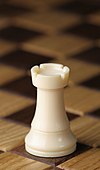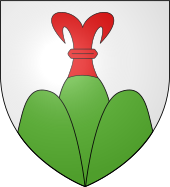Rook (chess)

|

|
| Chess pieces | |
|---|---|
|
|
king |
|
|
lady |
|
|
tower |
|
|
runner |
|
|
Jumper |
|
|
Farmer |
The tower ( Unicode : ♖ U + 2656, U + 265C ♜) is the second most powerful figure in the chess game . Together with the lady , he is one of the heaviest figures . A distinction is made in the basic position and in the opening between the lady's tower and the king's tower. The former is on the queenside , the white one is on the a1 square, the black on a8. The latter is posted on the kingside ; the white is on the field h1, the black on h8.
Moving opportunities and value
| a | b | c | d | e | f | G | H | ||
| 8th | 8th | ||||||||
| 7th | 7th | ||||||||
| 6th | 6th | ||||||||
| 5 | 5 | ||||||||
| 4th | 4th | ||||||||
| 3 | 3 | ||||||||
| 2 | 2 | ||||||||
| 1 | 1 | ||||||||
| a | b | c | d | e | f | G | H |
A tower can move horizontally as well as vertically over any number of spaces. He may move linearly to any free space in any direction, but without jumping over other pieces. The only exception to this is castling , during which the rook jumps over the king once . A row or line along the chessboard can move a rook over white and black fields and be placed on any other field as long as the path is free. In contrast to all other pieces, the rook always covers the same number of squares on the chessboard from any position - with a free path - namely 14. In castling, the king and rook are moved one after the other as part of the same move.
The value of the rook is given as five pawn units . As with all figures, this value can vary. The tower is limited in its possibilities of movement, especially in closed positions.
The tower in the three game phases
In the opening
In the initial phase of a game the rook plays a subordinate role as long as the pawns limit its trajectories. Its use often begins with castling, which moves the rook more towards the center ; or with heterogeneous (opposing) castling, by attempting to open the starting line of the rook by means of marginal pawn moves (for example h2 – h4 or h7 – h5 after a brief castling of the opponent) in order to support an attack on the king.
In the middle game
The tower is a typical middle game or end game piece . The more pieces that are taken out of the game in the course of the game, the better the tower can exploit its range. For this reason, as a player, you strive to position your rooks on open or semi-open lines, where they can best show their strengths. Often a party tries to exchange its own farmers or even to sacrifice them in order to open lines and thus open the way for their own towers.
If both towers of a player are on the same line, one speaks of a tower doubling . This is considered to be particularly advantageous because both towers cover and support each other.
The attacking targets of the towers are usually on the seventh or eighth row: If a tower reaches the seventh row, it can often attack pieces and pawns to the right and left of it at the same time. A rook on the eighth row can sometimes even checkmate if the opposing king is trapped behind its own pawn and the back row is not protected by other pieces (see basic row checkmate ).
In the endgame
The checkmate with rook and king against king is easy to do, but only by the opposing king is marginalized. Endgames with rooks and pawns are called rook endings ; these make up about half of all finals. If there is a material tie, they often tend to draw, but they require precise play.
history

The representation of the tower results from figures that show an elephant with a tower top. In the Indian game of chess, however, the elephants took the place of today's bishop (cf. alfil ).
Linguistically, the term rok (Sanskrit) or smell (Persian) for "field of vision" or "chariot" (in the sense of "straight attack with the chariot") developed over the term ruch to the Latin roccus and thus to the supposed same rocca ( Italian for castle). This is how the English name rook came about . Occasionally there was speculation about an etymological connection with the bird Roch of the oriental world of legends.
In medieval chess of Roch was the strongest figure because of Fers not yet on the possible moves of the lady possessed. For this reason, the tower or Roch was often used as a coat of arms figure .
heraldry

- see Roch (Heraldry)
literature
- Wassili Smyslow , Grigori Löwenfisch : Theory and practice of rook endings . Schachverlag Rudi Schmaus, Heidelberg 1985, DNB 850664470 .
